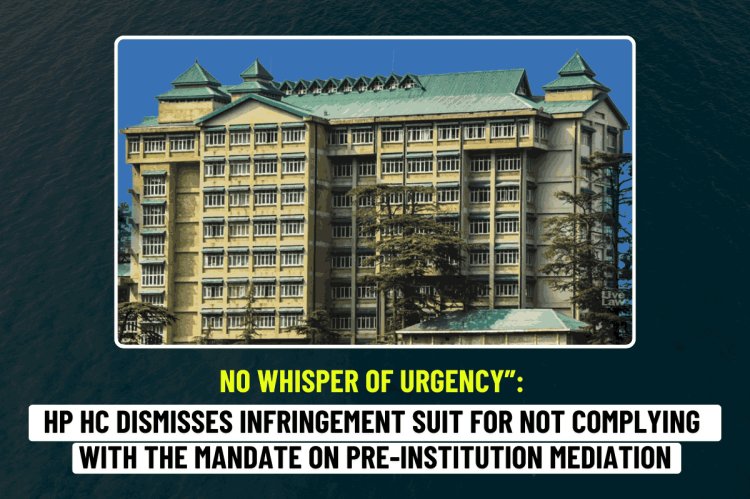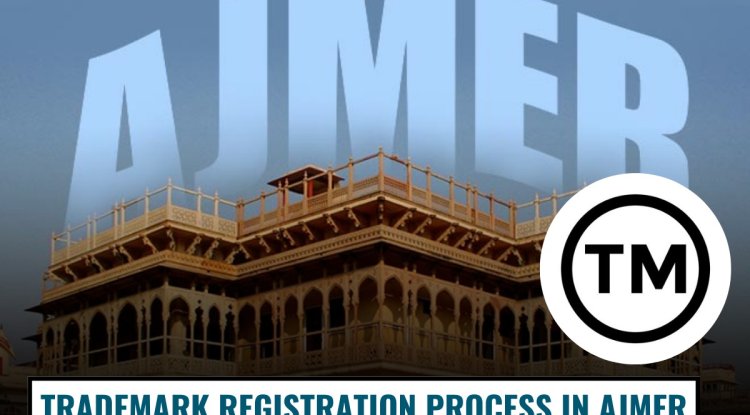No Whisper of Urgency”: HP HC Dismisses Infringement Suit for Not Complying with the Mandate on Pre-Institution Mediation
The Himachal Pradesh High Court recently dismissed an infringement suit due to non-compliance with the mandatory pre-institution mediation, which has now become an integral part of civil litigation procedures in India. The Court’s ruling was based on the absence of urgency claimed by the plaintiff and failure to follow procedural mandates before approaching the court. This article explores the legal backdrop of pre-institution mediation under the Commercial Courts Act, 2015, the significance of the judgment, and its broader implications for intellectual property (IP) litigation in India.

Introduction
In an era of increasing civil disputes and overloaded courts, pre-institution mediation has emerged as a significant step towards alternative dispute resolution (ADR) mechanisms. The introduction of mandatory pre-institution mediation under the Commercial Courts Act, 2015, aimed to resolve commercial disputes without resorting to formal litigation. The judiciary has taken steps to enforce this mandate, as illustrated by a recent ruling from the Himachal Pradesh High Court (HP HC), where an infringement suit was dismissed for failing to comply with the pre-institution mediation requirements.
The case is a vital reference point for understanding the importance of pre-institution mediation and the courts’ firm stance on ensuring compliance. The phrase “No whisper of urgency,” as used by the Court, speaks volumes about the significance of establishing urgency before skipping mandatory procedures.
Legal Framework: Pre-Institution Mediation under the Commercial Courts Act, 2015
The Commercial Courts Act, 2015, was enacted to streamline the resolution of commercial disputes and to provide a specialized legal framework for addressing high-stakes matters, such as intellectual property infringement, contract disputes, and other commercial transactions. One of the pivotal amendments introduced to this Act in 2018 was the mandatory pre-institution mediation under Section 12A.
The purpose of this amendment was to reduce the burden on courts by promoting settlement through mediation before litigants file their case in court. Section 12A stipulates that no suit involving a commercial dispute can be instituted unless the plaintiff has exhausted the remedy of pre-institution mediation. An exception is carved out only for cases where urgent interim relief is required, allowing plaintiffs to bypass mediation and approach the courts directly.
The Case: Infringement Suit Dismissed for Non-Compliance
In the infringement suit dismissed by the Himachal Pradesh High Court, the plaintiff had failed to undertake pre-institution mediation as mandated by Section 12A of the Commercial Courts Act, 2015. The plaintiff argued that urgency was involved due to the ongoing infringement of its intellectual property rights. However, the Court, after reviewing the facts of the case, observed that there was no genuine urgency to justify bypassing the mediation process.
In its ruling, the Court noted that the plaintiff’s pleadings contained “no whisper of urgency” and lacked any substantial evidence to suggest that the matter was so pressing that immediate judicial intervention was warranted. As a result, the suit was dismissed for failure to comply with the procedural mandates before instituting litigation.
Analysis of the Judgment
The ruling by the Himachal Pradesh High Court in this case is significant for several reasons:
- Reinforcement of Mediation as a First Step: The dismissal reinforces the court’s emphasis on mediation as a critical first step in resolving commercial disputes. The primary goal of pre-institution mediation is to reduce litigation by encouraging parties to reach an amicable settlement outside the courtroom. By dismissing the suit, the Court has sent a strong message that compliance with this procedural requirement is not optional but mandatory unless the circumstances clearly establish urgency.
- Balancing Efficiency with Urgency: The judgment also raises important questions about the balance between procedural efficiency and the need for urgency in IP infringement cases. While IP disputes often involve the potential for irreparable harm, not every case qualifies as urgent. Courts must carefully weigh whether an immediate remedy is truly warranted before allowing plaintiffs to skip mediation.
- Deterring Frivolous Claims of Urgency: By using the phrase “no whisper of urgency,” the Court aimed to deter litigants from making baseless claims of urgency to avoid the mandatory mediation process. This ruling signals that courts will not entertain such claims lightly and will scrutinize the facts carefully before permitting litigants to bypass procedural requirements.
Significance for Intellectual Property Litigation
Intellectual property (IP) litigation often involves time-sensitive issues, particularly in cases of trademark or patent infringement, where delays could lead to irreparable harm or financial losses. Traditionally, plaintiffs in such cases seek interim injunctions to prevent further infringement while the court adjudicates the dispute. However, the introduction of mandatory pre-institution mediation under the Commercial Courts Act has created a procedural roadblock that plaintiffs must navigate.
This ruling by the Himachal Pradesh High Court underscores the importance of adhering to the mediation mandate, even in IP cases where plaintiffs might feel urgency is inherent. Here are some key takeaways for IP litigation:
- No Automatic Assumption of Urgency in IP Cases: While it is common for plaintiffs to argue that intellectual property infringement cases are inherently urgent, the HP HC ruling clarifies that urgency must be explicitly demonstrated through facts and evidence. Courts will no longer accept urgency as a default argument without scrutinizing the circumstances.
- Compliance with Section 12A of the Commercial Courts Act: Plaintiffs must ensure full compliance with Section 12A of the Commercial Courts Act. This means initiating pre-institution mediation, unless the circumstances of the case genuinely warrant immediate judicial intervention.
- Judicial Efficiency and Court Overload: The enforcement of pre-institution mediation in commercial disputes, including IP cases, is an effort by the judiciary to reduce the burden on courts. The hope is that many disputes can be resolved amicably through mediation, leaving the courts free to handle only the most contentious matters. The HP HC’s dismissal of the infringement suit reinforces the judiciary’s goal of improving the overall efficiency of the legal system.
Loopholes in the Current Mediation Framework
Despite the laudable objective of reducing litigation through mediation, there are some inherent challenges in the existing framework:
- Lack of Mediation Infrastructure: The mediation process under the Commercial Courts Act is still evolving, and there is a lack of robust mediation infrastructure, especially in smaller courts across the country. Many litigants may not be aware of how to initiate the mediation process or how effective it can be.
- Delay in the Mediation Process: While mediation is intended to be a speedy process, in practice, it can sometimes lead to delays, particularly when one party is unwilling to negotiate in good faith. This can further delay access to courts, which might be problematic in urgent IP disputes.
Recommendations
To ensure the effectiveness of pre-institution mediation and avoid unnecessary litigation, the following steps could be considered:
- Strengthening Mediation Infrastructure: There is a need to strengthen mediation infrastructure across all courts in India. The creation of specialized IP mediation centers could be a valuable addition to the system, allowing for swift and expert-led dispute resolution.
- Clear Guidelines on Urgency: The judiciary could consider issuing clear guidelines on what constitutes urgency in intellectual property disputes. This would help litigants understand when they can legitimately bypass pre-institution mediation and directly approach the courts.
- Training for Mediators in IP Disputes: Mediation in intellectual property cases requires a nuanced understanding of IP law. Training programs should be developed to equip mediators with the expertise necessary to handle complex IP disputes effectively.
Way Forward
The Himachal Pradesh High Court’s ruling is a reminder of the critical role that pre-institution mediation plays in the resolution of commercial disputes, including intellectual property matters. Moving forward, it is crucial for litigants to view mediation not as a procedural hurdle but as an opportunity for resolving disputes efficiently and amicably.
Courts must continue to enforce the mandatory mediation mandate while remaining vigilant about genuine cases of urgency. At the same time, efforts must be made to improve the mediation process to ensure that it remains a viable and attractive option for litigants. With the right infrastructure, training, and guidelines in place, pre-institution mediation could serve as a valuable tool in reducing the burden on the judiciary and providing swift relief in IP disputes.
Conclusion
The dismissal of the infringement suit for failing to comply with pre-institution mediation is a landmark moment for enforcing Section 12A of the Commercial Courts Act. This ruling highlights the importance of mediation in the Indian legal system and underscores the judiciary's commitment to ensuring compliance with procedural mandates. For intellectual property litigants, the case serves as a cautionary tale, reminding them of the need to balance urgency with the necessity of following due process.












